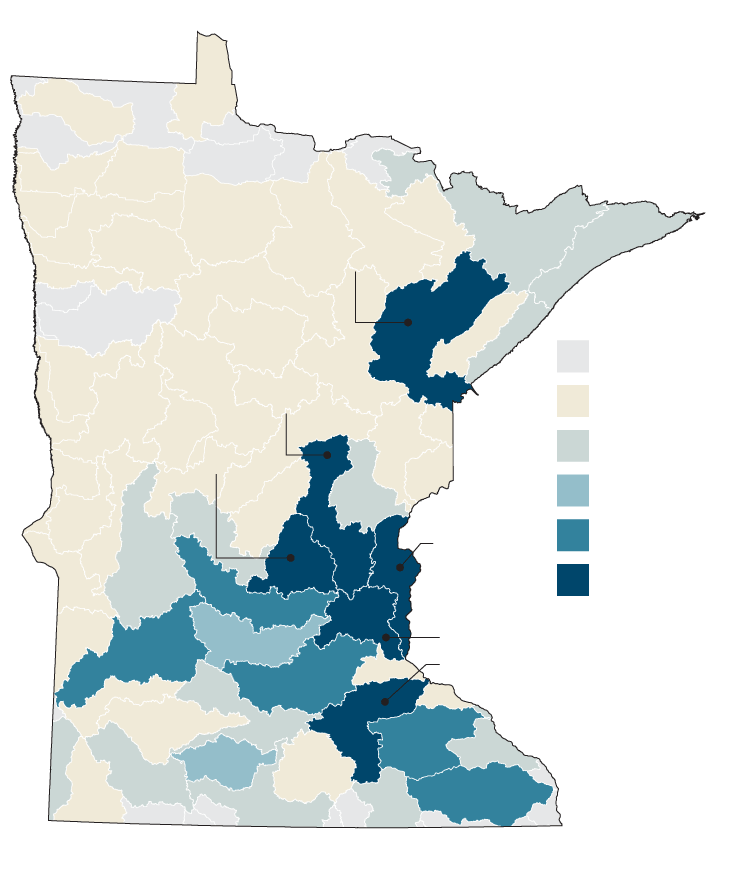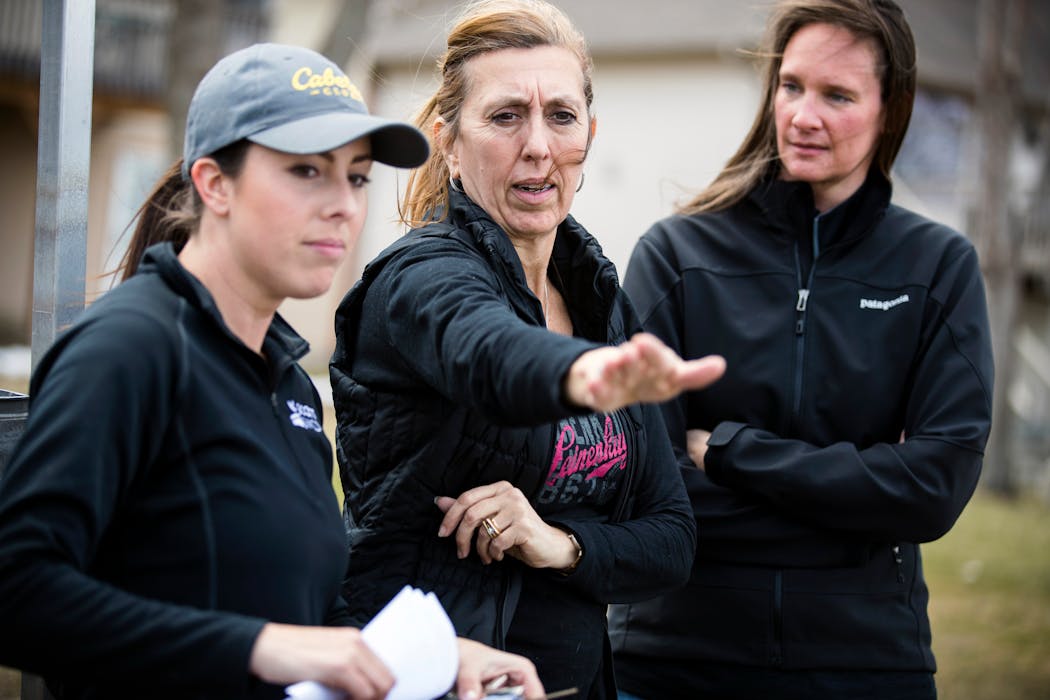When a massive rainstorm blew a chest-deep gully through Don Stocker's sloping cornfield in Scott County four years ago, it created a torrent of water, dirt and farm chemicals that rushed into Sand Creek and the Minnesota River downstream.
"It makes me mad," he said of the land his family has farmed for 150 years, "that my grandparents had to land in this hilly place."
There was a time when Stocker's only option would have been to plow up that ravine and keep right on farming it. But now his dirt stays where it belongs, thanks to a $36,000 grass waterway that winds through his fields like a giant green Slip 'N Slide — a project made possible by Minnesota's Clean Water Land and Legacy Amendment.
It has been 10 years since Minnesota voters agreed to change the state constitution with one of the most sweeping environmental mandates in the country — a 25-year plan to spend roughly $5.6 billion to protect land, wildlife and water in a state that prides itself on its love of the outdoors.
For two of the amendment's environmental targets — land conservation and parks and trails — Minnesota appears to be on track to meet Legacy's goals. Nearly a million acres of wild lands have been acquired or protected with $740 million from the Outdoor Heritage Fund. The $318 million from the Parks and Trails fund have built 1,200 miles of paved for bicycle trails, plus more for ATVs, snowmobiling and hiking, and added 300,000 acres of parks.
But despite $760 million spent so far on thousands of projects, including the one on Stocker's farm, the long-term outcome for clean water is still as cloudy as the sediment-filled Minnesota River.

State Rep. Jean Wagenius, an influential legislator on environmental issues, has called the clean water effort a "billion dollar failure" because drinking water across the state is still at risk. And Deborah Swackhamer, the University of Minnesota professor emeritus who spearheaded the design of the state's clean water plan, said she is disheartened by the lack of progress in protecting water from road salt, phosphorus, soil and farm chemicals.
"No, the water quality of the state is not improving," she said.
By some measures, it is improving, say state environmental officials. Since 1998, 46 of Minnesota's streams and lakes have improved enough to come off the state's long list of polluted bodies of water. Significantly, the state has used the first decade of Legacy money to identify, measure and track pollutants in all of its 80 major watersheds — an achievement that no other state can claim, said John Linc Stine, commissioner of the Minnesota Pollution Control Agency.
What that comes down to, said Paul Nelson, environmental director for Scott County, is that the state now knows what has to be done.
"What we don't know," he said, "is how to do it."
The state now has 15 years left to figure it out.
Two million trees
In 2008, during one of the most severe recessions in modern history, Minnesotans were asked to increase their sales tax by three-eighths of 1 percent for these lofty goals: "To protect our drinking water sources; to protect, enhance, and restore our wetlands, prairies, forests, and fish, game, and wildlife habitat; … to support our parks and trails; and to protect, enhance, and restore our lakes, rivers, streams, and groundwater … "
Sixty percent of voters said yes — a margin that was viewed as a sweeping mandate for the environment, and one that is still a cause of envy across the country.
"Minnesota is one of the great success stories for statewide ballot initiatives," said Erin Heskett, executive director of the Land Trust Alliance, which represents conservation groups nationally.
The tax generates $240 million to $300 million a year, with one-third going to the Outdoor Heritage Fund for land conservation and protection; one-third to the Clean Water Fund for water protection; and 14.5 percent to the Parks and Trails Fund. Another 20 percent, roughly, is dedicated to arts and culture.

The money has produced a cornucopia of benefits for the outdoors. There's an ambitious plan to restore a priceless strip of native prairie on the state's western edge. Some 250,000 acres of northern forests have been permanently protected, and more than two million trees have been planted to the specific tastes of Minnesota's declining moose population.
Thanks to the parks fund, thousands of kids — and grown-ups — have learned to fish, hunt, climb, camp, paddle and geocache, using park educational programs.
One measure of the impact, said DNR officials, is that a survey of 8,000 Minnesotans found that 70 percent now say outdoor activities are very important to them, up from 57 percent in 2004.
The water fund, too, has achieved some notable successes. Legacy money has leveraged millions more in federal funding to clean up the St. Louis River estuary near Duluth, the incubator for wildlife in the western half of Lake Superior, which was badly polluted by decades of industrial use.
And there is data. So much data that Stine of the PCA calls it "transformative." "We never dreamed we would have the kind of information … that we have now," he said.
The downside, he added, "is that now we know. And that is both a blessing and a curse."
It turns out that cleaning up polluted water is a lot harder than identifying it, because it means changing what people do on the land around it, said John Jaschke, head of the Minnesota Board of Water and Soil Resources.
"Our water," he said "is a reflection of the land we live on." And, he added, it's largely in private hands.
One measure of the challenge: At the current pace, even if Minnesota continues to spend some $100 million of Legacy money per year, only 8 percent of the lakes and streams deemed impaired will come off the state list by 2034.
The struggle to protect drinking water — long considered voters' first priority — tells the larger story.
In Brown County recently, commissioners voted not to participate in a state-sponsored private well testing program, even though it was free and voluntary for homeowners. Farmers and crop consultants objected because, they said, the state would use the data to justify regulating their use of fertilizers, which is vital to their crop yields.
That was part of the state's initial plan. But pushback from farm interests forced the Agriculture Department to scale back its new groundwater protection strategy. Now, its regulatory teeth won't help private well owners — only public community wells that serve larger populations and that the state is legally obligated to protect.
But protecting public drinking water systems has also been slow and difficult. Officials estimate that 360,000 acres surrounding community drinking water sources should be converted to grass, forest or other protective cover to keep the water clean. So far, only 9,900 acres have been converted. Health officials say many cities use other strategies to protect drinking water sources. Nonetheless, "Many landowners need to generate an income from land they own, so the options available to them are limited," said Randy Ellingboe, a manager at the state Health Department.
As for the Mississippi — the source of drinking water for St. Cloud and the Twin Cities — land use in its vast upstream watershed is beyond the control of the affected cities. "The only way those places will be protected is if local units of government step up,'' said Frank Jewell, chairman of the Clean Water Council, which oversees the fund. "There has to be enough of a public push that they do that."
Urban areas, of course, have their own problems: Driveways and parking lots flush phosphorus down storm sewers, and road salt is fouling nearby fresh water.
Whether the problem is fertilizer or road salt, the Legacy Amendment has, at best, brought Minnesota to the point "where we are managing trade-offs," Stine said. "There is no simple answer and there never will be."
'If everybody does a little bit'
In Scott County, however, private landowners are the answer. Yard by yard, and farm field by farm field, many are changing what they do on the land.
On a blustery April morning at Spring Lake, which is ringed by houses standing shoulder to shoulder, Meghan Darley and Melissa Hanson contemplated soggy patch of lawn next to the shoreline. Hanson, a homeowner, had heard that Darley's employer, the local Soil and Water Conservation District, would help install rain gardens to catch runoff and protect the lake.
The spreading puddle at their toes marked the spot.
"I think 300 square feet would be awesome," Darley said. "I think we can get creative with it."
Hanson said she's looking forward to adding more native plants, which attract butterflies and frogs to her yard. Even more gratifying, she said, is doing her little bit for the lake that's been her beloved neighbor for two decades.
OUTDOOR/CLEAN WATER RECIPIENTS
| Minn. Dept. of Natural Resources | $262.8 million |
| Minn. Board of Water & Soil Resources | $121.5 |
| Pheasants Forever | $103.6 |
| Minn. Pollution Control Agency | $101.0 |
| Soil & Water Conservation Districts | $48.4 |
| The Nature Conservancy | $42.3 |
| Ducks Unlimited, Inc. | $41.2 |
| Three Rivers Park District | $37.5 |
| Mpls. Park & Recreation Board | $34.5 |
| St. Paul Parks & Recreation | $23.9 |
And then some of the magic that the Scott County conservationists have been nurturing for years suddenly blossomed: Hanson introduced Darley to a neighbor who also wanted a raingarden.
"That was a twofer," a delighted Darley said as she hopped back into her truck. "That wasn't even planned!"
That shared environmental ethic is one reason why Scott County is one of the few places in Minnesota where water quality is improving. The strategy is built on years of landowner surveys and social science by Mae Davenport, a professor at the U. The point, "is not to tell that landowner what to do," she said. "It's building capacity and building community around conservation."
The strategy has worked equally well with farmers like Stocker, who rely on their land to make a living. The grass waterway on his field has worked so well that this spring he called the SWCD again when he found another, smaller area of erosion.
"They know what they are doing," he said as two hydrologists followed the trail that water had left in the rich clay soil of his cornfield.
The payoff for these efforts will be Sand Creek, which already appears to be carrying less sediment and runoff than it once did.
"If everybody does a little bit, it's all going to help down the line," Stocker said.
In the next 10 years, state officials generally agree, Minnesota will spend less on measuring water pollution and more on managing land use to prevent it.
With a grant from the Clean Water Fund, Davenport is conducting a huge survey to measure how much Minnesotans value water and what they're willing to do to protect it. She hopes her research can guide the state's choices.
Because the first 10 years of Legacy money has brought home one lesson that is as crystal clear as the waters Minnesotans yearn for, said Stine.
"You can't spend your way to clean water," he said.

Want to share info with the Star Tribune? How to do it securely

'Safe recovery sites' would offer syringes, naloxone and more to people using drugs. The plan could be in peril.
New Minnesota GOP leaders seek peace with party's anti-establishment wing

Who is Republican Lisa Demuth, Minnesota's first House speaker of color?




![Bill Gossman a potter and mayor of New London worked at his pottery studio Sunday April 29, 2018 in New London, MN.] jerry.holt@startribune.com](https://arc.stimg.co/startribunemedia/ZWUBKGTYZUIZ6HEBXKUHCSAVTA.jpg?w=600&h=600&auto=format%2Ccompress&cs=tinysrgb)